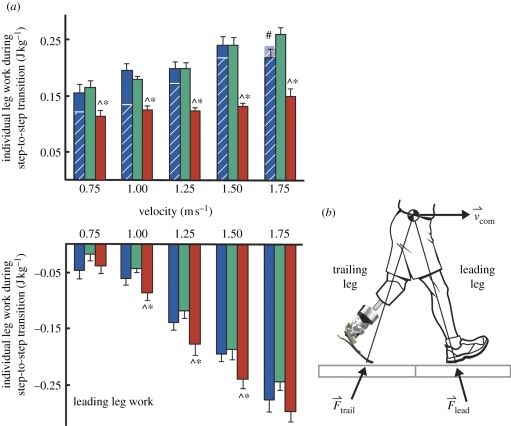Figure 4.
Step-to-step transition work. (a) Average individual leg mechanical step-to-step transition work from PWA using the bionic prosthesis (blue bars) was not different from non-amputees (green bars) except for trailing leg work at 1.75 m s−1. The leg using a prosthesis is always the trailing leg and the biological leg is always the leading leg in PWA. Average ankle work per step attributed to the bionic prosthesis (white stripes overlaid on trailing leg blue bars) comprised approximately 87% of the overall trailing leg work done on the centre of mass across all velocities. At 1.75 m s−1, the ankle work performed by the bionic prosthesis was greater than the trailing leg step-to-step transition work, implying that ankle work was dissipated at the knee and/or hip joints. PWA using a passive-elastic prosthesis (red bars) generated significantly less trailing leg work and experienced greater leading leg collision work compared with using the bionic prosthesis and to non-amputees. The hash sign (#) indicates a significant difference between PWA using the bionic prosthesis and non-amputees, asterisks (*) indicate significant differences between PWA using the bionic prosthesis compared with using a passive-elastic prosthesis, and carets (^) indicate significant differences between non-amputees and PWA using a passive-elastic prosthesis (p < 0.05). Error bars indicate s.e.m. (b) Step-to-step transition work equals the time-integral of mechanical power (Watts with respect seconds). Mechanical power is the dot product of each leg's ground reaction force (Ftrail and Flead) and the instantaneous centre of mass velocity (vcom) [44].

